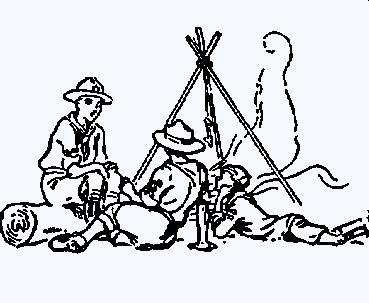
Camp Fire Yarn No. 3
BECOMING A SCOUT
Tenderfoot Test • Scout Law • Scout Promise • Scout Sign and Salute
Investiture
• Scout Uniform
To be A scout you should join a Scout Patrol or a Scout Troop in your neighbourhood, with the permission
of your parents.
But before becoming a Scout, you must pass the Tenderfoot Test. This is a simple test just to show
that you are worth your salt and mean to stick to it.
When you have satisfied your Scoutmaster, the man in Charge of your Troop, that you can do all the
things and do them properly, you will be invested as a Scout and be entitled to wear the Tenderfoot Badge.
SCOUT LAW
The Scout Law contains the rules which apply to Boy Scouts all the world over, and which you promise
to obey when you are enrolled as a Scout. The Scout Law is in the front of this book (pages xi, xii and xiii). Study it carefully
so that you understand the meaning of every point.
SCOUT PROMISE
At your investiture as a Scout you will make the Scout Promise in front of the rest of the Troop.
The Scout Promise you will find on page xi.
This Promise is a very difficult one to keep, but it is a most serious one and no boy is a Scout unless
he does his best to live up to his Promise.
So you see, Scouting is not only fun, but it also requires a lot from you, and I know I can trust you
to do everything you possibly can to keep your Scout Promise.
SCOUT MOTTO
The Scout Motto is: BE PREPARED which means you are always in a state of readiness in mind and body
to do your DUTY.
Be Prepared in Mind by having disciplined yourself to be obedient to every order, and also by having
thought out beforehand any accident or Situation that might occur, so that you know the right thing to do at the right moment,
and are willing to do it.
Be Prepared in Body by making yourself strong and active and able to do the right thing at the right
moment and do it.
SCOUT BADGE
The Scout Badge is the arrowhead which shows the North on a map or on a compass. It is the Badge of
the Scout because it points in the right direction, and upwards. It shows the way in doing your duty and helping others. The
three points of it remind you of the three points of the Scout Promise.
This arrowhead has come to be the Badge of the Scouts in almost every country in the world. In order
to distinguish one nationality from the other, the country's own emblem is often placed on the front of it.
The badge of a Second Class Scout is a scroll with the Scout Motto, "Be Prepared". The scroll is turned
up at the ends like a Scout's mouth, because he does his duty with a smile and willingly.
Beneath the scroll is a cord with a knot tied in it. This knot is to remind you to do a good turn daily
to someone.
Together the Scout Badge and the scroll form the badge of a First Class Scout.
SCOUT SIGN AND SALUTE
The Scout Sign is made by raising your right hand to shoulder height, palm to the front, thumb resting
on the nail of the little finger, and the other fingers upright, pointing upwards. The three fingers remind a Scout of the
three parts of the Scout Promise. The Scout Sign is given at the making of the Promise, or as a greeting. When the band held
in this way is raised to the forehead, it is the Scout Salute.
When to Salute
All wearers of the Scout Badge ought to salute each other once a day. The first to see the other Scout
is the first to salute, irrespective of rank.
Scouts will always salute as a token of respect, at the hoisting of the Flag; at the playing of the
National Anthem; to the uncased
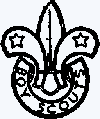 
National Colours; to Scout Flags, when carried ceremonially; and to all funerals. On these occasions,
if the Scouts are acting under Orders, they obey the Orders of the person in Charge in regard to saluting or standing to the
alert. If a Scout is not acting under orders he should salute independently. In all cases, leaders should salute. The band
salute is only used when a Scout is not carrying his staff, and is always made with the right band. Saluting when carrying
a staff is done by bringing the left arm smartly across the body in a horizontal position, the fingers showing the Scout Sign
just touching the staff.
When in uniform a Scout salutes whether he is wearing a hat or not, with one exception, namely at religious
Services, when all Scouts must stand at the alert, instead of saluting.
The Meaning of the Salute
A man once told me that "he was just as good as anybody else, and he was blowed if ever he would raise
a finger to salute his so-called 'betters'; he wasn't going to be a slave and kow-tow to them, not he!" and so on.
That is a churlish spirit, which is common among fellows who have not been brought up as Scouts.
I didn't argue with him, but I might have told him that he had the wrong idea about saluting.
A salute is a sign between men of standing. It is a privilege to be able to salute anyone.
In the old days freemen were all allowed to carry weapons, and when one met another each would hold
up his right band to show that he had no weapon in it, and that they met as friends. So also when an armed man met a defenceless
person or a lady.
Slaves or serfs were not allowed to carry weapons, and so had to slink past the freemen without making
any sign.
Nowadays people do not carry weapons. But those who would have been entitled to do so, such as knights,
esquires, and men-at-arms, that is, those living on their own property or earning their own living, still go through the form
of saluting each other by
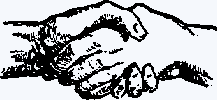
holding up their hand to their hat, or even taking it off. "Wasters" are not entitled to salute, and
so should slink by, as they generally do, without taking notice of the freemen or wage-earners.
To salute merely shows that you are a right sort of fellow and mean well to the others. There is nothing
slavish about it.
If a stranger makes the Scout Sign to you, you should acknowledge it at once by making the Sign back
to him, and then shake hands with the LEFT HAND-the Scout Handshake. If he then shows his Scout Badge, or proves that he is
a Scout, you must treat him as a Brother Scout, and help him.
INVESTITURE OF A SCOUT
Here is a suggested ceremonial for a recruit to be invested as a Scout:
The Troop is formed in horseshoe formation, with Scoutmaster and Assistant Scoutmaster in the gap.
The Assistant Scoutmaster holds the hat of the recruit. When ordered to come forward by the Scoutmaster, the Patrol Leader
brings the recruit to the centre. The Scoutmaster than asks: "Do you know what your honour is?"
The recruit replies: "Yes. It means that I can be trusted to be truthful and honest" (or words to that
effect).
"Do you know the Scout Law?"
"Yes."
"Can I trust you, on your honour, to do your best to live up to the Scout Promise?"
Recruit then makes the Scout Sign, and so does the whole Troop while he gives the Scout Promise.
Scoutmaster: "I trust you, on your honour, to keep this Promise. You are now a Scout in the World-wide
Brotherhood of Scouts".
The Scoutmaster gives him his badges and the Assistant Scoutmaster then hands him his hat. The Patrol
Leader then fastens on his Patrol shoulder knot.
The Scoutmaster shakes hands with him with the left hand.
The new Scout faces about and salutes the Troop.
The Troop salutes.
The Scoutmaster gives the word, "To your Patrol, quick march".
The new Scout and his Patrol Leader march back to their Patrol.
GOING ON IN SCOUTING
When you have been invested as a Scout you can go on to the next grade, that of Second Class Scout.
For this you will learn the beginnings of many useful subjects. The Badge of the Second Class Scout is the scroll alone, with
the Scout Motto.
No Scout will want to remain Second Class for longer than he need and so you will become a First Class
Scout as soon as you can. This will mean hard work tackling map-reading, hiking, first aid, and many other things. The First
Class Badge consists of both the arrow-head and the scroll.
You can also win Proficiency Badges for your hobbies.
SCOUT UNIFORM
The Scout Uniform is very like the uniform worn by my men when I commanded the South African Constabulary.
They knew what was comfortable, serviceable, and a good protection against the weather. So Scouts have much the same uniform.
With a few minor alterations the original Scout Uniform has met the ideas of Scouts around the world
and has been universally
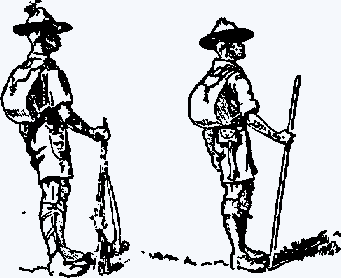
adopted. Of course, in extreme climates it has to be modified to suit the seasons, but on the whole
the different nations in the temperate climates are dressed uniformly alike.
Starting at the top, the broad-brimmed khaki hat is a good protection from sun and rain. It is kept
on by a bootlace tied in a bow in front on the brim and going round the back of the head. This lace will come in handy in
many ways when you camp. The hat has four dents in it.
Then comes the scarf or neckerchief which is folded into a triangle with the point at the back of the
neck. Every Troop has its own scarf colour, and since the honour of your Troop is bound up in the scarf, you must be very
careful to keep it clean and tidy. It is fastened at the throat by a knot, or "woggle", which is some form of ring made of
cord, metal, or bone, or anything you like. The scarf protects your neck from sunburn and serves many purposes, such as for
a bandage or as an emergency rope.
The Scout shirt (or Jersey) is a free-and-easy thing, and nothing could be more comfortable when the
sleeves are rolled up. All Scouts have them rolled up because this tends to give them greater freedom, but also as a sign
that they are ready to carry out their Motto. They only roll them down when it is very cold or when their arms may become
sunburnt. In cold weather the shirt can be supplemented with warmer garments over or, better, under it.
Shorts are essential to hard work, to hiking and to camping. They are less expensive and more hygienic
than breeches or trousers. They give freedom and Ventilation to the legs. Another advantage is that when the ground is wet,
you can go about without stockings and none of your clothes gets damp.
The stockings are held up by garters, with green tabs showing below the turnover of the stocking top.
Personally, I consider shoes more suitable than high boots since they give better Ventilation to the
feet and therefore diminish the danger of chills and of chafes which come from damp stockings softening the feet when tightly
laced boots are worn.
Wearing the Uniform
The Scout kit, through its uniformity, now constitutes a bond of brotherhood among boys across the
world.
The correct wearing of the Uniform and smartness of turnout of the individual Scout makes him a credit
to our Movement. It shows his pride in himself and in his Troop.
One slovenly Scout, on the other hand, inaccurately dressed may let down the whole Movement in the
eyes of the public. Show me such a fellow and I can show you one who has not grasped the true Scouting spirit and who lakes
no pride in his membership of our great Brotherhood.
SCOUT STAFF
The Scout staff is a useful addition to the kit of the Scout. Personally, I have found it an invaluable
assistant when traversing mountains or boulder-strewn country and especially in night work in forest or bush. Also, by carving
upon it various signs representing his achievements, the staff gradually becomes a record as well as a treasured companion
to the Scout.
The Scout staff is a strong stick about as high as your nose, marked in feet and inches for measuring.
The staff is useful for all sorts of things, such as making a stretcher, keeping back a crowd, jumping
over a ditch, testing the depth of a river, keeping in touch with the rest of your Patrol in the dark. You can help another
Scout over a high wall if you hold your staff horizontally between your hands and make a step for him; he can then give you
a hand from above.
Several staves can be used for building a light bridge, a hut or a flag staff.
There are many other uses for the staff. In fact, you will soon find that if you don't have your staff
with you, you will always be wanting it.
If you get the chance, cut your own staff. But remember to get permission first.
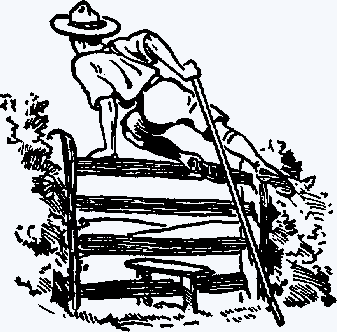
| 
